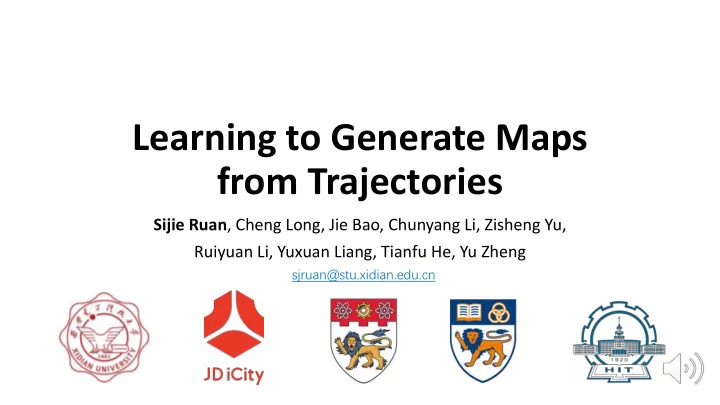

Learning to Generate Maps from Trajectories Sijie Ruan , Cheng Long, Jie Bao, Chunyang Li, Zisheng Yu, Ruiyuan Li, Yuxuan Liang, Tianfu He, Yu Zheng sjruan@stu.xidian.edu.cn
Increasing Demands of Accurate & Updated Maps Navigation Route Planning & Real-time Scheduling
Traditional Map Data Collecting Methods Low Spatial Coverage On-field Study Dynamic Traffic Status
Crowdsourcing GPS Trajectories GPS Devices Massive Moving Objects Real-time City-wide Map Information
Challenges Positioning Error (~15 meters) Difficult to Distinguish Spatially Close Roads Low Sampling Rate (30s/pt) Ground Truth Map Ambiguous Underlying Traversing Routes
Framework of DeepMG
Geometry Translation (1/2) • Feature Extraction • For each 𝐽 × 𝐾 Region Tile 2×𝑈×𝑈×𝐽×𝐾 ) Spatial View ( ℝ 11×𝐽×𝐾 ) Transition View ( ℤ 2 1 1 0 0 … neighborhood c 0 0 1 0 (b) Local Incoming Matrix. (c) Local Outgoing Matrix. (a) Transitions S/E at c. Point, Line, Speed, Direction (8 channels) Each grid cell has an incoming and an outgoing matrix
Geometry Translation (2/2) • T2RNet • Transition Embedding • Shared Encoder • Road Region Decoder • Road Centerline Decoder • Optimization • Dice Loss [Milletari F, et al. 2016] • Multi-task Loss Milletari F, et al. “ V-net: Fully convolutional neural networks for volumetric medical image segmentation ”. 3DV. 2016.
Topology Construction (1/2) • Graph Extraction • Merge predicted tiles • Extract road segments • Link Generation • For each dead end 𝑓 2 𝑓 1 • Case 1: intersects another edge on the extension 𝜄 𝑃 • Case 2: has smooth transition to the closest dead end of another edge 𝑓 3
Topology Construction (2/2) • Map Refinement • Perform trajectory map matching on the linked map [Yuan J, et al. 2010] • Remove edges and links with low support If the map matching is directly applied… Proposed solution Inferred path 𝑄 1 Real path 𝑓 1 𝑚 1 𝑚 3 𝛽 > 1 𝑄 2 𝑓 2 𝑓 3 𝑚 2 Yuan J, et al. “ An Interactive Voting-based Map Matching Algorithm ”. MDM. 2010.
Evaluation • Datasets • Evaluation Metrics • Trajectory • Topological F1 [Biagioni, et al. 2012] • <oid, timestamp, latitude, longitude> • Repeat 𝑂 times • Map a. Select a random starting location • Node: <latitude, longitude> b. Find reachable area within a maximum radius c. Compare generated map with GT using F1 • Edge: <start_node, end_node> • Report the average F1 score Biagioni J, Eriksson J. “ Inferring road maps from global positioning system traces: Survey and comparative evaluation ”. Transportation research record. 2012.
Results • Quantitative Comparison TaxiJN (6.5% improvement) TaxiBJ (32.3% improvement) • Visual Comparison
Practice in JD.COM: Resident Area Map Generation from JD Couriers’ Trajectories X
Conclusion • A valuable but challenging task • Position errors • Low sampling rate • Our method • Geometry translation (T2RNet) • Convolutional network: learns the structure of the road network • Auxiliary task: helps the centerline inference • Topology construction (Link + Prune) • Trajectories as transition evidences • Results • Superior than traditional methods • More effective on low-sampling rate datasets
Thanks! JD iCity JD Urban Spatio-Temporal Data Engine (JUST) Ruan S., et al. “ Learning to Generate Maps from Trajectories ”. AAAI. 2020.
Recommend
More recommend